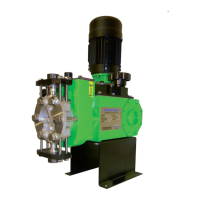Leak Detection Diaphragm systems require special hydraulic priming considerations
to protect the diaphragm from damage during initial pump startup. See Appendix I on
page 33 for further information.
6.2 Suction System
Before operation of any PULSAR pump, carefully ensure that all suction valves are in the open
position. Verify that all filters and strainers are clean and clear. Ensure that any other potential
causes of restriction have been addressed. Unrestricted flow of liquid to the suction side of the
pump is critical to proper operation.
6.3 Priming the Pump head (Hydraulic System)
All pumps are shipped with a fully primed hydraulic system. However, during shipping and
handling some air may enter the hydraulic system. Generally, this air will be automatically
purged after a short run-in period. If necessary, rapid purging may be accomplished by fully
depressing and holding the PTP valve while the pump is operating. With the valve depressed,
oil should begin to flow out of the center diagnostic port. Continue to hold the valve down until
the oil is clear of bubbles.
If the pump fails to prime, go to the next section and follow the Priming the Pump head
procedure (Section 7.2.2). See Appendix I on page 33 for further information if your pump is
equipped with a PULSAlarm leak detection system.
6.4 Priming the Reagent Head (Product System)
1. Open the suction and discharge line shutoff valves.
2. If the piping system design and the storage tank are such that the product flows due to
gravity through the pump, no priming is required. In the event the discharge line contains a
significant amount of pressurized air or other gas, it may be necessary to lower the
discharge pressure to enable the pump to self-prime.
3. If the installation involves a suction lift, it may be necessary to prime the reagent head and
suction line. Try priming the reagent head first. Remove the discharge valve by unscrewing
the four tie bar bolts and removing the valve as a unit. Fill the head through the discharge
valve port with process (or compatible) liquid, then reinstall the valve and retighten the tie
bar bolts.
4. Start the pump at the 0% stroke length setting and slowly increase the setting to 100% to
prime the pump. If this does not work, it will be necessary to fill the suction line.
5. Filling of the suction line will necessitate the use of a foot valve or similar device at the end
of the suction line so that liquid can be maintained above the reservoir level. Remove the
suction valve assembly, fill the line, replace the valve, then remove the discharge valve
assembly and fill the reagent head as described in Step (3) above. The pump will now self-
prime when started up per step (4) above.

